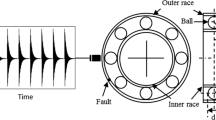Abstract
In the condition based maintenance work of rotating machineries, bearings’ fault diagnosis and prognosis are an important content. Their faults can lead to many disasters. So, to detect the bearing faults earlier can benefit the remaining useful life (RUL) prediction and maintenance actions. In order to achieve this goal, narrowband interference cancellation (NIC) is used to extract the periodic impulsive signals which are indicative of a bearing fault. This method filters the narrowband signals not associated with the impulsive signal produced by bearing faults out. Therefore, the signal-to-noise will be improved and lead to the easier fault detection. However, only easier fault detection is not enough for RUL prediction. The features extracted from the vibration signals should reflect the bearings’ degradation well. This needs the features have good degradation trend (increase or decrease with time). In order to demonstrate the effectiveness of the proposed method, one implemented bearing fault test and one run-to-failure test are used to do the analysis. The results shows that bearing faults detection can be enhanced and root mean square (RMS) extracted from the NIC signal can track the bearing degradation well than the RMS extracted from the original vibration signal.










Similar content being viewed by others
References
Antoni J, Randall RB (2004a) Unsupervised noise cancellation for vibration signals: part I—evaluation of adaptive algorithms. Mech Syst Signal Process 18(1):89–101
Antoni J, Randall RB (2004b) Unsupervised noise cancellation for vibration signals: part II—a novel frequency-domain algorithm. Mech Syst Signal Process 18(1):103–117
Antoni J, Randall RB (2006) The spectral kurtosis: application to the vibratory surveillance and diagnostics of rotating machines. Mech Syst Signal Process 20(2):308–331
Bechhoefer E, Kingsley M, Menon P (2011) Bearing envelope analysis window selection using spectral kurtosis techniques. IEEE conference on prognostics and health management, Montreal
Bechhoefer E, Li RY, He D (2012) Quantification of condition indicator performance on a split torque gearbox. J Intell Manuf 23(2):213–220
Chaturvedi GK, Thomas DW (1982) Bearing fault detection using adaptive noise cancelling. J Sound Vib 104(2):280–289
Eftekharnejad B, Carrasco MR, Charnley B, Mba D (2011) The application of spectral kurtosis on acoustic emission and vibrations from a defective bearing. Mech Syst Signal Process 25(1):266–284
Fault Data Sets (2013) http://www.mfpt.org/. Accessed 20 June 2013
Ho D (2000) Bearing diagnostics and self adaptive noise cancellation. Ph.D. dissertation, UNSW
Jardine AKS, Lin D, Banjevic D (2006) A review on machinery diagnostics and prognostics implementing condition-based maintenance. Mech Syst Signal Process 20(7):1483–1510
Jiang KS, Xu GH, Liang L, Zhao GQ, Tao TF (2012) A quantitative diagnosis method for rolling element bearing using signal complexity and morphology filtering. J VibroEng 14(4):1862–1875
Klein R, Rudyk E, Masad E, Issacharoff M (2011a) Emphasizing bearing tones for prognostics. Int J Cond Monit 1(2):73–78
Klein R, Rudyk E, Masad E, Issacharoff M (2011b) Model based approach for identification of gears and bearings failure modes. Int J Progn Health Manag 2(2):009
Manolakis D, Ingle V, Kogon S (2005) Statistical and adaptive signal processing. McGraw-Hill, New York
Sawalhi N, Randall RB, Endo H (2007) The enhancement of fault detection and diagnosis in rolling element bearings using minimum entropy deconvolution combined with spectral kurtosis. Mech Syst Signal Process 21(6):2616–2633
Tan CC, Dawson B (1987) An adaptive noise cancellation approach for condition monitoring of gearbox bearings, In: Proceedings of the international tribology conference, Melbourne
Wang W, Wong AK (2002) Autogressive model-based gear fault diagnosis. J Vib Acoust 124(2):172–179
Yang M, Makis V (2010) ARX model-based gearbox fault detection and localization under varying load conditions. J Sound Vib 329:5209–5221
Zhu KS, Song XG, Xue DX (2013) Incipient fault diagnosis of roller bearings using empirical mode decomposition and correlation coefficient. J VibroEng 15(2):597–609
Acknowledgments
This project is supported in part by the Chinese government research program under grant no. 51327020304.
Author information
Authors and Affiliations
Corresponding author
Rights and permissions
About this article
Cite this article
Zhang, X., Kang, J., Bechhoefer, E. et al. Enhanced bearing fault detection and degradation analysis based on narrowband interference cancellation. Int J Syst Assur Eng Manag 5, 645–650 (2014). https://doi.org/10.1007/s13198-014-0217-6
Received:
Revised:
Published:
Issue Date:
DOI: https://doi.org/10.1007/s13198-014-0217-6



